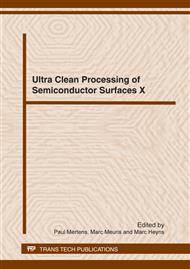[1]
M. -S. Liang, Challenges in Cu/Low-K integration, IEDM Technical Digest, pp.313-316, (2004).
Google Scholar
[2]
R. Fox et al., High Performance k=2. 5 ULK Backend Solution Using an Improved TFHM Architecture, Extendible to the 45nm Technology Node, IEDM 2005 Technical Digest, pp.87-90.
DOI: 10.1109/iedm.2005.1609272
Google Scholar
[3]
E. Richard et al., Manufacturability and Speed Performance Demonstration of Porous ULK (k=2. 5) for a 45nm CMOS Platform, proceedings of VLSI 2007 conference.
Google Scholar
[4]
L. Broussous et al., Porous Low-k Wet Etch in HF-based Solutions : Focus on Cleaning Process Window, "Pore-sealing" and "k recovery,. Solid State Phenomena Vols. 145-146 (2009) pp.295-302.
DOI: 10.4028/www.scientific.net/ssp.145-146.295
Google Scholar
[5]
S. Lamy et al., Characterization of photoresist poisoning induced by a post etch stripping step, proceedings of the IEEE 2002 International Interconnect Technology Conference (Cat. No. 02EX519), 2002, pp.30-2.
DOI: 10.1109/iitc.2002.1014877
Google Scholar
[6]
M. Assous et al., Porous dielectric dual damascene patterning issues for 65 nm node: can architecture bring a solution?, proceedings of the IEEE 2003 International Interconnect Technology Conference (Cat. No. 03TH8695), 2003, pp.97-9.
DOI: 10.1109/iitc.2003.1219723
Google Scholar
[7]
K. Ueno, et. al., Cleaning of CHF3 Plasma-etched SiO2/SiN/Cu Via structures with Dilute Hydrofluoric Acid Solutions, J. Electrochem. Soc., Vol. 144, No 7, July (1997).
DOI: 10.1149/1.1837856
Google Scholar
[8]
L. Broussous, et al., Post-Etch Cleaning Chemistries Evaluation for low-k Cu integration, Solid State Phenomena, Vol. 92 (2003), p.263~266.
DOI: 10.4028/www.scientific.net/ssp.92.263
Google Scholar
[9]
Mei Qi Weng et al., Metal Hard mask employed Cu/Low k Post Etch Resist Ash/Wet Clean Process Optimization and Integration into 65nm Manufacturing Flow, UCPSS 2006 proceedings.
DOI: 10.4028/www.scientific.net/ssp.134.359
Google Scholar
[10]
A. Lagha et al., Comprehensive study on Metal-Fluoride Crystals issues with Trench First Hard Mask Backend architecture, _Sematech Surface Preparation & Cleaning Conference 2007. a) Line lithography with organic BARC b) HM etch and via lithography (organic BARC) c) Partial via etch and resist removal d) Line etch and SiCN open e) Metal deposition & direct CMP Fig 1 : Trench First Hard Mask Back-end architecture, with metallic Hardmask. Defect Height > TiN thickness Fluorine homogeneous distribution Almost no oxygen in the defect thickness Fig 2: Energy filtered TEM elemental mapping on a metal fluoride crystalline residue.
DOI: 10.4028/www.scientific.net/ssp.282.250
Google Scholar
[10]
a c b 1 µm 0. 5 µm 2 µm 5 µm 0. 5 µm 1 µm d e f Fig 3: SEM observation. a, b, c_ 24hrs after line etch : Metal fluoride crystals. d, e_ clean surface after wet process MS8500 50°C, 40s. f_some defects remains after wet process MS8500 35°C, 90s. Fig 4: High density Via Chain Yield / per split Chain A & B with 25 million via @ min. pitch (wide = space = 70nm) Fig 5: Metal 1 _ R C plot @ min. pitch (w=s=70nm)_ all wafers, grouped by split.
DOI: 10.7554/elife.31476.005
Google Scholar


